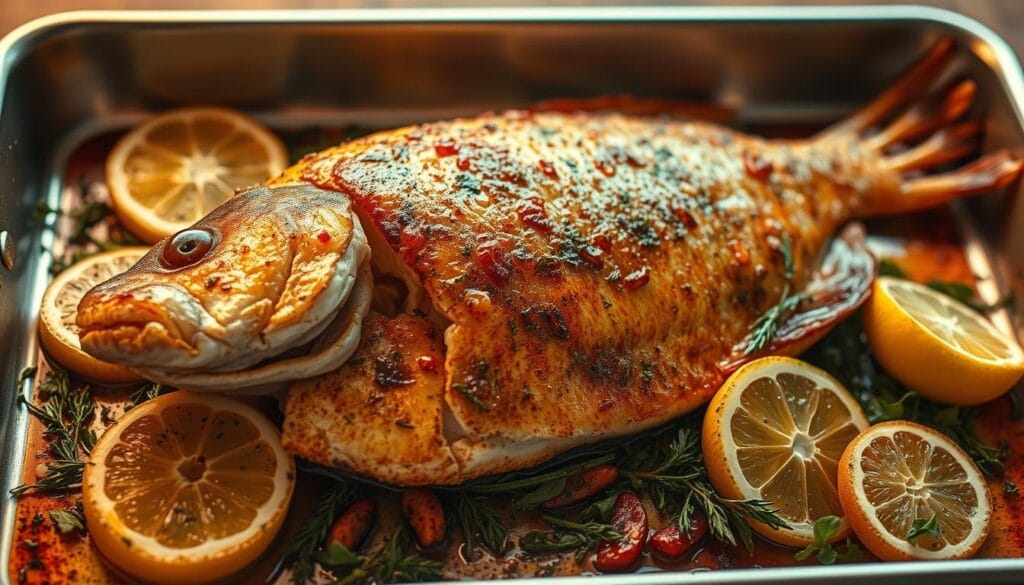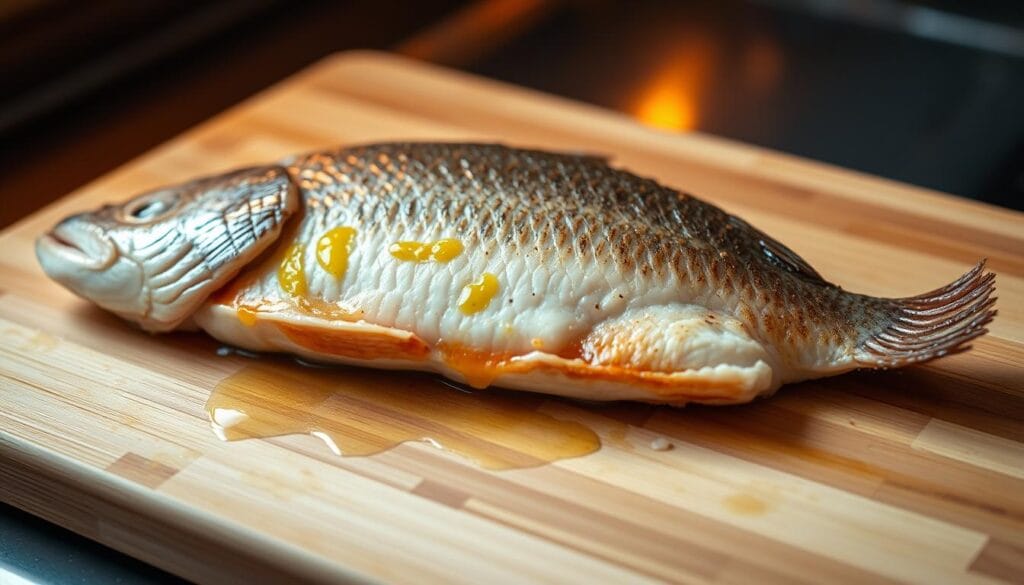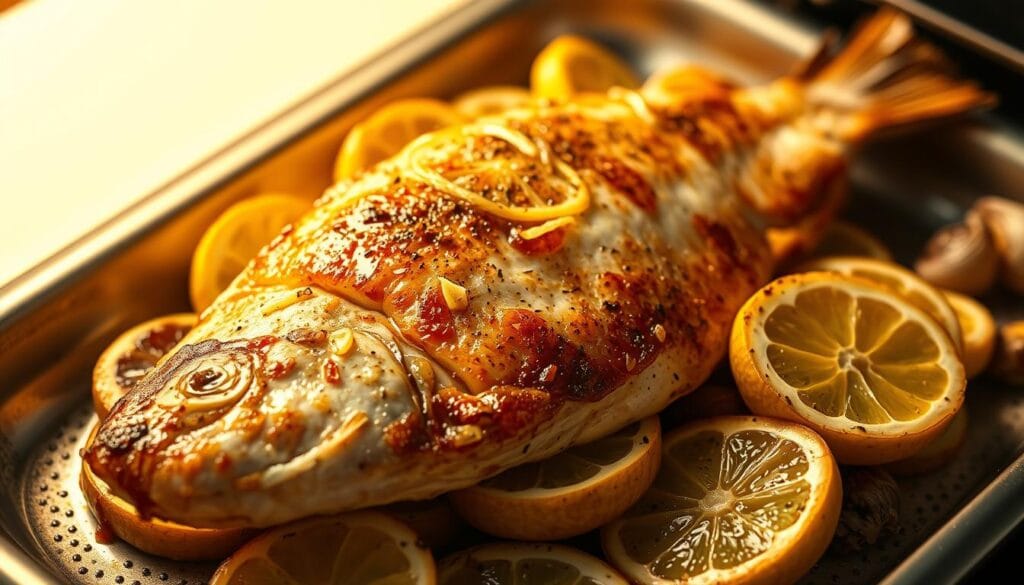Cooking tilapia in the oven is easy and healthy. It keeps the fish’s delicate flavor and nutrients intact.
Oven-baked tilapia is a tasty dish loved by seafood fans. It’s a quick and healthy meal that needs just a few ingredients and effort.
Key Takeaways
- Learn how to cook tilapia in the oven with simple ingredients.
- Discover the health benefits of baking tilapia.
- Find out how to achieve a crispy exterior and a tender interior.
- Get tips on seasoning and marinating tilapia for enhanced flavor.
- Understand the importance of proper cooking techniques.
Table of Contents
The Nutritional Benefits of Tilapia
Tilapia is a nutrient-rich food that offers many health benefits. It’s a great choice for a healthy diet. It has high protein content and essential vitamins and minerals.
Protein Content and Lean Properties
Tilapia is packed with protein, which is key for muscle growth and repair. It’s also low in fat, making it a lean protein. “One of the reasons I love tilapia is because it’s affordable, mild & delicious, and a healthy choice – packed with omega-3 fatty acids and high-quality protein,” a health enthusiast noted.
Comparison to Other Fish
Compared to other fish, tilapia has less fat but still lots of omega-3 fatty acids. This makes it a great choice for those watching their fat intake but still want nutritional value.
Essential Vitamins and Minerals
Tilapia is a good source of vitamins and minerals like vitamin B12, selenium, and phosphorus. These nutrients are important for healthy bones, teeth, and a strong immune system.
Health Benefits for Different Dietary Needs
Whether you’re on a low-carb diet, a keto diet, or just looking for a nutritious meal, tilapia is a good option. Its high protein and low fat content fit various dietary needs.
Selecting the Perfect Whole Tilapia
Finding the right whole tilapia is key to a delicious dish. Whether you’re a pro in the kitchen or just starting, knowing the difference between fresh and frozen tilapia is important. It’s also crucial to choose sustainable options.
Fresh vs. Frozen Tilapia
Choosing between fresh and frozen tilapia depends on your recipe and taste. Fresh tilapia is firmer and best used right away. Frozen tilapia is just as good and lasts longer.
Thawing Techniques for Frozen Fish
If you choose frozen tilapia, thawing it right is essential. Thaw it in the fridge overnight or under cold water for faster thawing. Never thaw it at room temperature to avoid bacterial growth.
Signs of Freshness to Look For
For fresh tilapia, check for clear, bright eyes and red gills. It should feel firm and smell fresh, not too fishy.
Red Flags to Avoid
- Dull or sunken eyes
- Discoloration or strong odor
- Soft or mushy texture
Sustainable Sourcing Considerations
Choose tilapia that’s sustainably raised. Look for ASC (Aquaculture Stewardship Council) or BAP (Best Aquaculture Practices) certifications. They show the fish was farmed responsibly.
Essential Tools and Equipment
To cook whole tilapia in the oven, you need the right tools and equipment. This includes the right baking dishes, tools for preparation, and devices for checking temperature.
Baking Dishes and Pans
Choosing the right baking dish is key for cooking whole tilapia. You can pick from glass, ceramic, or metal pans, each with its own benefits.
Material Considerations
Glass and ceramic dishes spread heat evenly. Metal pans can give a nice brown color to the fish. Make sure your dish is big enough for the whole tilapia.
Kitchen Tools for Preparation
You’ll need different kitchen tools to get your tilapia ready. This includes a sharp knife for scaling and gutting, a cutting board, and kitchen shears.
Safety Precautions
Always be careful with sharp objects. Also, make sure your cutting board is stable to avoid accidents.
Temperature Monitoring
It’s important to check the temperature accurately to cook your tilapia perfectly. Use an oven thermometer to check your oven’s temperature.
Preparing Your Whole Tilapia
To cook your whole tilapia perfectly, start by preparing it right. This means cleaning and scaling, gutting and removing gills, and scoring the fish. These steps help it cook evenly.
Cleaning and Scaling
Cleaning and scaling are key first steps. First, rinse the tilapia under cold water to get rid of loose debris.
Step-by-Step Process
- Rinse the tilapia under cold water.
- Use a scaler or the back of a knife to remove scales.
- Rinse again to remove any remaining scales.
Gutting and Removing Gills
Gutting and removing the gills are vital for cleanliness and flavor.
Handling Tips for Beginners
If you’re new to whole fish prep, use a sharp, thin-bladed knife. Make a precise cut from the belly up to the gills. Then, remove the innards and gills carefully, avoiding the intestines.
Scoring the Fish for Even Cooking
Scoring the tilapia ensures it cooks evenly. It also lets flavors penetrate deeper into the meat.
Knife Techniques and Patterns
Make diagonal cuts on both sides of the fish, about 1 inch apart. This method helps with even cooking and looks great.
Basic Tilapia Seasoning Techniques
Seasoning is crucial for bringing out the best in whole tilapia when baked. You need to know the basics of seasoning and how to improve them.
Salt and Pepper Foundation
A solid seasoning starts with salt and pepper. These two enhance the tilapia’s natural taste without being too strong.
Proper Seasoning Amounts
Getting the right amount of salt and pepper is key. Use about 1/4 teaspoon of salt and 1/8 teaspoon of pepper for each pound of fish. But feel free to adjust to your liking.
Herb and Spice Combinations
Herbs and spices can add a lot to your tilapia. Try fresh herbs like parsley, dill, or thyme. Or spices like paprika, garlic powder, or cumin.
Regional Flavor Profiles
Each region has its own flavor style. For example, Mediterranean tilapia might have oregano, lemon, and garlic. Asian-style tilapia could have soy sauce, ginger, and sesame oil.
Marinating Tips and Timing
Marinating can make your tilapia even tastier. The trick is to find the right balance between marinating time and marinade strength.
Acid-Based vs. Oil-Based Marinades
Acid-based marinades, like lemon juice or vinegar, tenderize the fish but should be used briefly. Oil-based marinades can be used for longer times.
Learning these basic seasoning techniques will help you make many tasty dishes.
Delicious Whole Tilapia Recipes to Try

Explore the rich flavors of whole tilapia with recipes from around the world. This versatile fish can be seasoned and cooked in many ways. It’s perfect for any meal.
Mediterranean Style Tilapia
Mediterranean cuisine pairs well with tilapia’s mild taste. Key ingredients include lemon, garlic, and herbs like parsley and oregano.
Lemon and Herb Variations
Try different lemon and herb mixes for unique flavors. A squeeze of fresh lemon and some chopped parsley can brighten the dish.
Asian-Inspired Flavors
Asian flavors add a bold, savory touch to tilapia. Soy sauce, ginger, and sesame oil are common ingredients.
Soy and Ginger Combinations
Mix soy sauce and ginger for a rich flavor. Marinate the tilapia in a soy sauce, ginger, and garlic mix for a tasty dish.
Cajun and Spicy Variations
For spicy lovers, Cajun and spicy tilapia is exciting. Ingredients like paprika, cayenne pepper, and hot sauce add heat.
Heat Level Adjustments
Adjust the spice to your taste by adding more or less spicy ingredients. This lets you tailor the dish to your liking.
Step-by-Step Oven Baking Method
To cook whole tilapia perfectly, follow these steps. Oven baking is easy and makes the fish taste great.
Preheating and Temperature Settings
First, heat your oven to 400°F (200°C). This is the best temperature for baking whole tilapia. Preheating ensures even cooking and keeps flavors locked in.
Convection vs. Conventional Oven Adjustments
Convection ovens cook faster and more evenly. You might need to lower the temperature by 25°F (15°C). Also, check for doneness a bit earlier.
Proper Fish Placement
Put the tilapia on a baking dish or pan covered with foil or parchment paper. This makes cleanup easier and prevents sticking. Make sure the fish is in the center and not touching the edges.
Using Foil or Parchment Paper
Wrapping the tilapia in foil or using parchment paper keeps it moist. For a crispy skin, bake without wrapping. Brush the fish with oil to prevent drying.
Timing Guidelines for Perfect Doneness
Cooking time depends on the fish’s size. A 1-pound (450g) fish takes 10-12 minutes to bake. A 2-pound (900g) fish takes 20-24 minutes.
Size-Based Cooking Times
- 1 pound (450g): 10-12 minutes
- 1.5 pounds (675g): 15-18 minutes
- 2 pounds (900g): 20-24 minutes
Check if the fish is done by flaking easily with a fork. It should also have an internal temperature of 145°F (63°C).
Alternative Cooking Methods for Whole Tilapia
There are many ways to cook whole tilapia, each bringing its own taste and texture. Oven baking is popular, but grilling, pan-frying, and steaming offer new flavors to try.
Grilling Techniques
Grilling tilapia gives it a smoky taste and a crunchy outside. It’s important to choose the right heat.
Direct vs. Indirect Heat
Direct heat makes the fish cook fast, creating a nice char. Indirect heat cooks it more evenly, so it doesn’t get too dry.
Pan-Frying Approach
Pan-frying makes the tilapia crispy on the outside and soft inside. The secret is using the right oil and keeping the heat just right.
Oil Selection and Temperature Control
Use oil that doesn’t burn easily, like avocado oil. Keep the heat medium-high to get a golden crust without overcooking.
Steaming Options
Steaming is a healthy way to cook tilapia that keeps its flavor. Try it with ginger and soy sauce for a taste of Asia.
Asian-Style Steaming Methods
Steam the tilapia in a basket over boiling water. Season it with ginger, garlic, and soy sauce. Cover the steamer to keep the steam in. Cook for 8-10 minutes, until it’s fully cooked.
How to Tell When Your Tilapia is Perfectly Cooked

To make sure your tilapia is cooked just right, you need to know what to look for. Checking doneness is key for both safety and taste.
Visual Indicators
One of the first signs of doneness is a change in appearance. Cooked tilapia turns opaque and flakes easily.
Color and Texture Changes
Raw tilapia looks translucent. As it cooks, it becomes opaque and firm. Look for these visual cues to gauge doneness.
Texture Tests
Testing the texture is another reliable method. Use a fork to gently flake the fish.
Fork and Knife Techniques
Insert a fork or the tip of a knife into the thickest part of the fish. If it flakes easily without resistance, it’s done. This method is simple yet effective.
Internal Temperature Guidelines
For a more precise check, use a food thermometer to measure the internal temperature.
Safe Cooking Temperatures
The USDA recommends cooking fish to an internal temperature of at least 145°F (63°C). Make sure the thermometer is in the thickest part of the fish for an accurate reading.
Serving Suggestions and Accompaniments
After baking your whole tilapia to perfection, it’s time to serve it. Choose accompaniments that boost its flavor and look. A complete meal makes dining more fun and fulfilling.
Complementary Side Dishes
Side dishes can really bring out the taste of tilapia. Try pairing it with sautéed veggies or fried plantains. They offer a nice mix of textures.
Sauce Pairings
Sauces can add a lot of flavor to your tilapia. A Mediterranean yogurt sauce or spicy mango salsa are great choices. They add a burst of taste.
Presentation Tips
How you present your dish matters a lot. Add fresh herbs like parsley or dill. A slice of lemon on the side also looks good.
Garnishing for Visual Appeal
Make your dish pop with colorful ingredients. A sprinkle of paprika or a few cherry tomatoes can brighten up your plate.
Storing and Reheating Leftover Tilapia
Enjoying leftover tilapia starts with the right storage and reheating. If you’ve cooked more than you can eat at once, knowing how to store and reheat is key. It keeps your food safe and tasty.
Proper Storage Methods
Storing leftover tilapia correctly is crucial. You have two main choices: refrigeration and freezing.
Refrigeration vs. Freezing
- For up to 3 days, refrigerate in an airtight container.
- Freeze for longer storage. Wrap in plastic or foil, then in a freezer-safe bag.
Safe Reheating Techniques
Reheating leftover tilapia safely is important. It helps avoid foodborne illness.
Maintaining Moisture and Flavor
- Reheat in the oven with a splash of lemon or olive oil to keep it moist.
- Use a food thermometer to ensure it reaches 145°F (63°C).
Creative Ways to Use Leftovers
Leftover tilapia can be turned into tasty new dishes.
Tilapia Salads and Tacos
- Flake the tilapia and mix with greens, veggies, and dressing for a salad.
- Top tacos with tilapia, salsa, avocado, and your favorite toppings.
Conclusion
You now know how to make a tasty and healthy oven-baked whole tilapia. It’s full of protein and vitamins, making it a great choice for a healthy meal.
Just follow the steps in this article to cook a perfect tilapia. You can try different flavors like Mediterranean, Asian, or Cajun. Oven-baked tilapia recipes are easy and delicious.
Cooking whole tilapia in the oven is easy and impressive. With the right seasonings and techniques, you’ll make a dish that everyone will love. So, try it out and enjoy the delicious and healthy meal.

